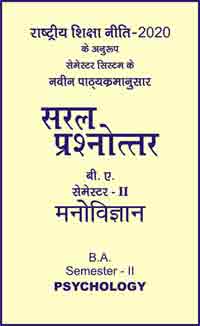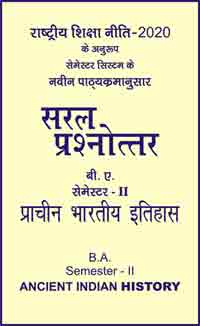|
बी एड - एम एड >> बी.एड. सेमेस्टर-1 प्रश्नपत्र-IV-B - वैल्यू एण्ड पीस एजुकेशन बी.एड. सेमेस्टर-1 प्रश्नपत्र-IV-B - वैल्यू एण्ड पीस एजुकेशनसरल प्रश्नोत्तर समूह
|
5 पाठक हैं |
||||||
बी.एड. सेमेस्टर-1 प्रश्नपत्र-IV-B - वैल्यू एण्ड पीस एजुकेशन (अंग्रेजी भाषा में)
Role of Culture and Civilization in Indian Education Value
- The view of culture as a tool kit and the definition of culture presented in the text share which of the following in common?
(a) culture is a physical artifact
(b) culture is language
(c) culture is shared
(d) culture helps us navigate and make sense of our social worlds -
Which of the following is an example of culture as a shared system of meanings?
(a) the form of buildings
(b) the act of creating artwork
(c) a community's subsistence pattern
(d) a parent teaching a child appropriate ways to address an elder -
A child helping a caregiver set the table is learning about proper table etiquette through the process of:
(a) Socialization
(b) enculturation
(c) acculturation
(d) the developmental niche -
Nationality refers to:
(a) a person’s place of birth
(b) the language one speaks
(c) a person’s ethnic identity
(d) the country to which a person emigrates -
An individual who lives and participates in more than one cultural setting is:
(a) bilingual
(b) bicultural
(c) biathletic
(d) bisymbolic -
Ethnicity refers to:
(a) a person’s place of birth
(b) group members who share beliefs, customs, practices, language, and ancestry
(c) individuals who live in more than one cultural setting
(d) native parenting practices -
One difference between ethnicity and nationality is that ethnicity is:
(a) permanent
(b) connected to a person’s country of birth
(c) set at birth
(d) a free-flowing, social construct -
George Simel classified human aggregates units
(a) Societies
(b) Communities
(c) Groups
(d) Institutions -
The essence of secondary group experience is
(a) Intimate relationships.
(b) Face-to-face contacts.
(c) Casualness of contacts.
(d) “Consciousness of kind” -
The preferential feeling which individual have for their own group is called
(a) Egoism.
(b) Ethnocentrism.
(c) Primary.
(d) Fraternal. -
A group of individuals having essentially the same social status in a given society is called a
(a) Social group.
(b) Social class.
(c) Struggle.
(d) Secondary group. -
Which one of the following is not strictly speaking, one of Freud’s stages of psycho sexual development?
(a) Genital
(b) Oral
(c) Oedipal
(d) Phallic -
A situation where a student is expected by his parents to study his lessons and is expected by his room-mates to visit a movie-house illustrates
(a) Status conflict.
(b) Primary-secondary group conflict.
(c) Role conflict.
(d) Culture conflict. -
Individual and society are considered as
(a) Interdependent,
(b) Contradictory,
(c) Complementary,
(d) Supplementary. -
Human nature develops in man as a
(a) Member of a religion.
(b) Citizen of a state.
(c) Member of an organisation.
(d) Member of a society. -
Man’s behaviour in society is determined mainly by two forces, namely
(a) Formal and informal.
(b) Natural and unnatural.
(c) Physical and social.
(d) Psychological and philosophical. -
Identify a quasi-group among the following,
(a) Status groups.
(b) Trade union.
(c) Mob.
(d) Crowd. -
An individual starts learning from
(a) Mother’s womb,
(b) Adulthood,
(c) Childhood.
(d) Adolescence. -
Suggestion is one of the basic principles of
(a) Human behaviour.
(b) Caste.
(c) Class.
(d) Socialization. -
One of the basic principles of socialing individuals is
(a) Religion.
(b) Caste.
(c) Education.
(d) Imitation. -
When the child is able to judge the response of a group as a whole, he is responding to a
(a) "Particular other".
(b) "Insignificant other".
(c) "Generalised other".
(d) "Significant other". -
Internalization means that the individual
(a) Conforms to group norms.
(b) Has identity, social location, aspiration and values.
(c) Has adopted the norms and values of the group and uses them.
(d) Has standards to judge his own behaviour. -
The concept of the looking-glass self may be summarised as follows
(a) What ego thinks ego is.
(b) What alter thinks ego is.
(c) What ego thinks, alter thinks, ego is.
(d) What ego thinks alter is. -
The process which aims to destroy the opponent is
(a) Co-operation.
(b) Conflict.
(c) Competition.
(d) Accommodation. -
When a group of clans get merged together, then the resultant grouping is called
(a) Lineage.
(b) Siblings.
(c) Family.
(d) Gotra. -
The preferences and aversions amongst the various members of a group is shown by
(a) Sociogram.
(b) Sociological analysis.
(c) Social psychology.
(d) Interactional analysis. -
"Birds of the same feather flock together" refers to the idea of a socialising process known as
(a) Imitation.
(b) Suggestion.
(c) Identification.
(d) Sympathy. -
The price paid to the Muslim bride is called
(a) Dowry.
(b) Bride Price.
(c) Mehar.
(d) Compensation. -
In early Hindu society, widow remarriage was
(a) Permitted.
(b) Protected.
(c) Promoted.
(d) Prohibited. -
The laws of Muslim marriage are based on
(a) Quran.
(b) Muslim law.
(c) Indian contract act.
(d) Constitution of India. -
Education conference 1947 was held in ?
(a) Peshawar
(b) Lahore
(c) Quetta
(d) Karachi -
Objective of education under education conference 1947 were ?
(a) Conformity with Ideology of life
(b) Economic development
(c) Character formation
(d) All of above -
According to the recommendations of Indian Education Commission, govt. took the responsibility of ?
(a) Primary education
(b) Secondary education
(c) Religious education
(d) Higher education -
Council of Technical Education was recommended to establish under ?
(a) Education conference 1947
(b) National Education commission 1959
(c) National education policy 1970
(d) Natural education policy 1972 -
National Education Commission 1959 was established under the headship of ?
(a) Fazal ur Rhman
(b) Liaqat ali khan
(c) S.M Sharif
(d) Abdul rub nishtar -
Objectives of education under National Education Commission 1959 were ?
(a) Spiritual values
(b) Ideology of Pakistan
(c) Development of individuality
(d) All of the above -
Text Book Board was recommended to establish under ?
(a) Education conference 1947
(b) National Education commission 1959
(c) National education policy 1970
(d) Natural education policy 1972 -
National Education Policy 1970 was headed by ?
(a) Fazal ur Rehman
(b) S.M Sharif
(c) Noor khan
(d) Abdul Hafeez Pirzada -
Private educational institutions were nationalized under ?
(a) Education conference 1947
(b) National Education commission 1959
(c) National education policy 1970
(d) Natural education policy 1972 -
Which is not a form of social stratification?
(a) Religion
(b) Class
(c) Caste
(d) Gender -
Which of the following is not true in the context of Culture?
(a) Culture is Cultivated
(b) Culture and Civilization are two faces of the same coin
(c) Culture refers to non material, while civilization refers to material aspect.
(d) Culture is what we have while the civilization is what we are. -
Which of the following is not related to modernization?
(a) Change in social structure
(b) Transformation of Society from backwardness to forwardness.
(c) Establishment of one's own identity
(d) Adoption of Science based technology -
The most powerful agent of Social change is ;
(a) Teacher
(b) Students
(c) Parents
(d) School management -
Which one of the following is not related to democracy?
(a) People exercise their power for governance
(b) Democratic state seeks to satisfy the basic needs of the people
(c) Democracy is shared experience leading to growth
(d) Democracy seeks to break down a class and caste distinction. -
“Educational Sociology is the study of the interaction of the individual and his cultural environment.” This was stated by
(a) Brown.
(b) Carter.
(c) Ottoway.
(d) Skinner. -
Application of principles of sociology to education is known as
(a) Sociology of education.
(b) Educational sociology.
(c) Social foundations of education.
(d) Social science of education. -
Schools are social institutions because they
(a) Preserve and instill in future generations the knowledge, ideas, and customs of our culture.
(b) Suggest ways and means of social progress.
(c) Suggest solutions to social problems.
(d) Are established by the society. -
Education conference 1947 was presided by ?
(a) Quaid e Azam
(b) Fazal ur Rehman
(c) Liaqat ali khan
(d) Abdul Rub Nishtar -
The technique of measurement of the patterns of social behaviour in a group is known as
(a) Sociogram.
(b) Interactional, analysis.
(c) Social distance scale.
(d) Sociometry.
|
|||||













